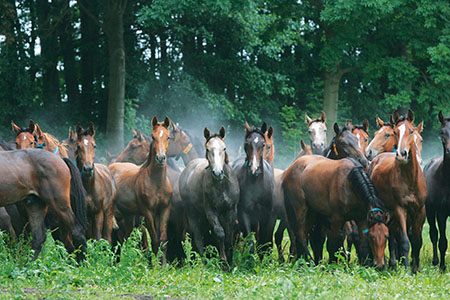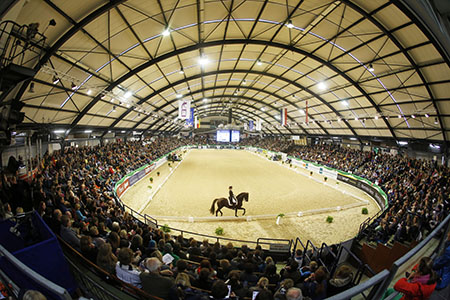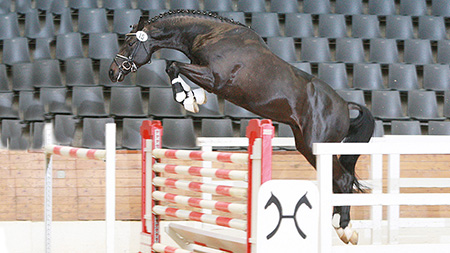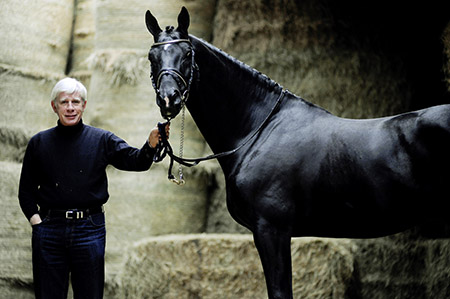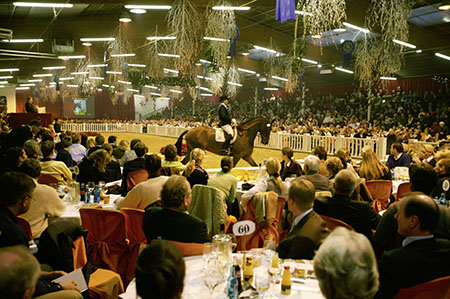The PSI empire started in 1974 when the brothers Alwin, Paul and Werner decided to purchase stallions to stand at their parents’ farm in Mühlen. Breeding has always been a tradition with the Schockemöhle family, father Alois and grandfather Alwin had owned stallions before.
The Lewitz Stud herd
The first group of stallions were a mixed lot: the Oldenburger stallion Fanal, the French Anglo-Arab Paladin, the Belgian-bred Granit and the Hanoverian Fürst Ferdinand. Granit (Goldfalk – Flügel van la Roche) had been a top showjumper with Paul Schockemöhle before he was sold to Leon Melchior for the then record sum of one million Deutsch-Mark.
Fürst Ferdinand was selected as a foal by Paul and Werner. He began his career with the Snoek family, then after a stint at Mühlen, he was leased to the State Stud Celle and eventually became one of the foundation sires for Zangersheide in Belgium.
In 1975 Alwin left the partnership, and the stallions Wettstreit (Hanoverian by Wedekind – Fernruf) and Colorado (Anglo-Arab) were added to the ranks.
The Hanoverian stallion Grundstein I (Graphit – Sermon I – Gotthard) was a great success – and an allrounder, siring both dressage and jumping horses, before he was sold to the United States..
Werner was a huge fan of the Gotthard son, Godehard, who covered many mares over 12 years, but while the progeny could jump, they were also massive and his influence disappeared.
At first the Schockemöhle line up didn’t feature dressage lines, but that changed when Paul purchased Sandro in 1985. At first Sandro provided great jumpers, the combination with Gepard mares produced Sao Paulo, Silvio I and II and Sandro Song, the sire of Sandro Hit, and Sandro Hit was to usher in a whole new era of dressage breeding at Mühlen.
The Holstenhalle in Neumünster, home to the VR Classics and the FEI World Cup this year
Although the dressage stallions attract now attract many mares, Paul Schockemöhle’s first love remains jumping. He founded the Springpferdezuchtverband Oldenburg-International (OS) and has been its chairman ever since. I caught up with him at Neumünster, the show he runs with his partner, Ulli Kasselmann, for this interview:
When I interviewed you in 1998, the Oldenburg jumping book was only 12 months old – have you been happy with the way it has developed in 16 years…
“I think we are already the fourth or fifth biggest studbook in Germany. You know breeding takes a long time, from covering a mare to competing in a Grand Prix in Aachen, but our studbook has already produced some Grand Prix horses and international horses.”
“I think it was an important step, to found our studbook, because the breeders, especially the breeders in Oldenburg, were trying to breed dressage horses with mares with jumping lines and they were mixing everything up. I think if you want to be successful, then you have to really specialize, with the right breeding lines for dressage, and the right lines for jumping.”
“I think the Oldenburg studbook is now in a very good situation. The results are improving, in dressage as well as jumping, and the two studbooks, they are not merged, but we handle it equally, we have a head committee of four people, two from the dressage studbook, and two from the jumping studbook. The Oldenburg studbook has had so much success because of the stallion owners – you can’t change all the mares – but the stallions normally decide the fate of a studbook. The stallions are owned privately and they are in competition with each other, and that produces very good stallions.”
But the amazing thing is that since we talked last, many of those great Oldenburg stallion stations have disappeared, Vorwerk, Seifert, Kathmann, Gronwöhldhof… really there is only Sosath and yourself remaining…
“Sprehe also, but like I said, it is a big competition between the stallion owners. Okay in general, we are friends, but in the business we are competitors and that always finally brings better results. That is a big advantage against government owned studbooks.”
But is it a worry that some of the great old stallion stations are dead?
“There are coming new ones as well, everything that is private and subject to competition will change with time. That is normal. Unluckily some breeding stations disappeared but probably they didn’t have modern enough stallions.”
All over Europe the breeders are saying that the number of mares being bred is down, maybe 50%, is this happening to you?
“Not so much, at my station probably the decrease is not bigger than 5% because we really try to get connections with other breeding stations all over Europe – I have connections to Holland, Joep van Uytert, we have connections to Denmark with Blue Hors and Helgstrand. I have some stallions together with the family Linsenhoff, and all this makes it possible to have the stallions that we have.”
Which stallions do you see as the stars of jumping breeding at the moment?
“Difficult to say. If you look at the start lists at any big show, there are a lot of stallions making top horses. It is not like fifteen or twenty years ago when you had an outstanding stallion like Landgraf, who was absolutely the star in Holstein and all over Germany. Now we have quite a lot of different lines which are producing good horses. At the moment, the star in Westfalia is Cornet Obolensky, the star in Hanover is Stakkato, the star in Holstein… there were three or four, Landgraf, Cassini, Lord and so on, and now there are sons of them, Caretino was one of them, and Casall is for sure the most popular stallion in Holstein.”
Diarado, co-owned with the Holstein Breeding Association and Joop van Uytert, Netherlands
Will Diarado compete in Grand Prix competition?
“I hope so, at the moment it looks like that. Last week and the week before, we had our stallion presentations and he really jumped very well. He did his first S classes last year and in every class he jumped, he was great.”
How important is French blood in your program?
“To work with French blood is quite important, in Oldenburg and Holstein as well, they really used Cor de la Bryère quite a lot to refine the horses. In general you have to be careful with the French horse, they are a little bit less good to ride than most of the German horses, but they are very brave, they are not spooky, that helps quite a lot. Diamant de Sémilly, the father of Diarado, has been very successful himself in the sport, and number one in France, so it is good to have a stallion here from his bloodline.”
How important is it that the stallion has a Grand Prix career?
“It is the way of the future. A lot of government owned stallions weren’t shown, they were just used for breeding, but those days are over. You see it more and more, in France, in Holland, in Belgium, they show the stallions, they compete, and these stallions will be used by the breeders – no doubt.”
Paul with Totilas, the stallion he jointly owns with the Linsenhoff / Rath family and purchased for a reported 10 to 15 Million Euro
Do you see a day when there will just be one German studbook?
“Okay between the studbooks there are very different structures. I know there is a lot of talk about the German Warmblood horse, but I think that will take quite a lot of time before the studbooks unify and make one studbook, because of the structures. We talk about that in Oldenburg, and the people there think it is good that we are independent.’
But some people say that your stables in Mühlen are in fact the national stud of the German horse…
“That’s not right. Okay we have a lot of stallions, luckily I have some breeders, but we are not the only one, and like I said, we have competition.”
Is it becoming to easy in the day of the internet, and beautiful looking brochures, to ‘manufacture’ a stallion?
“No, I think today you order fresh semen from anywhere in Europe and I think that is good for the breeding of horses, especially the breeders who really take care which stallion is the right one for his own mare. The breeder who really thinks about it, not just going to the nearest station and taking a stallion from there. The times of just going next door are over, and they are the breeders who didn’t get any money for their foals and they are the people who are finished with breeding. Now there are breeders who are much more educated, they know much more about the horses. They are using the internet and YouTube to see the stallions all around Europe to see where they are investing and that helps a lot.”
Auction time

